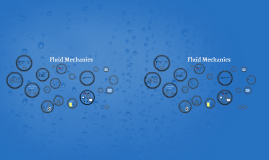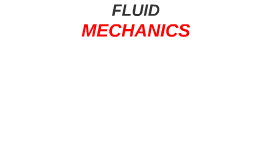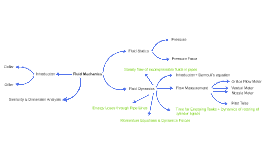Fluid Mechanics
Transcript: Fluid travels from a region of high to low pressure, but... (Peck 2010) 2. creates a region of low pressure We can now calculate pressure... How does fluid travel up a straw? Energy can only change between different forms. The total energy of a fluid is made up of: Kinetic energy Potential Energy Pressure energy (Tsankov 2015) Total energy = Kinetic energy + Potential energy + Pressure energy The kinetic energy of a fluid is due to its movement Therefore, the energy at P1 is the same as at P2 The amount depends upon: Pressure acting on the fluid Density of the fluid Which states.... References (continued) Bernoulli's Equation Energy is gained from pumps The Mechanical Energy Equation is similar to Bernoulli's Equation, but it takes into account: Smith, T 2014, Impeller, Learn Engineering, viewed 14th October 2015 <https://www.learnengineering.org/2014/01/centrifugalhydaulic-pumps.html> What is a fluid? In this example, point 1 is in the pipe, while point 2 is in the house. Yap, J 2012, Drinking water with a straw, Omninox, viewed 14th October 2015 <https://www.omninox.org/blog/how-does-drinking-water-with-a-straw-work/> Prager, J. King, K. Carlson, D. 2009, Bernoulli's principle, TeachEngineering, viewed 13 October 2015 <https://www.teachengineering.org/view_lesson.php?url=collection/cub_/lessons/cub_bernoulli/cub_bernoulli_lesson01.xml> A fluid is... When the impeller spins, the pressure at the inlet is less than the atmospheric pressure surrounding the fluid. With this assumption, the energy of a fluid at two different points in a pipe is the same Potential energy = mass x gravity x height (Evans 2015) A Centrifugal Pump works like sucking a straw, but on a larger scale... From the assumptions we can remove some parts from the equation as given below. a substance which takes on the shape of its container due to moving and changing shape easily References (continued) Kinetic energy = 1/2 x mass x velocity squared (King, Prager & Carlson 2009) Rollins, L 2015, A charming cartoon sunny day, Dreamtime Images, viewed 14th October 2015 <https://www.dreamtime.com> Before we start the calculation, what is atm? 1 atm is the atmospheric pressure at sea level 1atm=101300Pa The following principle can be applied to describe this movement... The total energy is constant! Therefore we can say: Fluid at a high pressure has more energy than fluid at a lower pressure. The high pressure fluid wants to have the same energy as the fluid around it The high pressure fluid will flow to low pressure, decreasing its total energy van Zyl, R 2012, Fluid Pumping, Learn Langa, viewed 12th October 2015 <https://www.learnmpumalanga.co.za/artcles/pumps/et-submersible-pumps.html> Tsankov, C 2015, Water faucet with water drop, 123RF, viewed 14th October 2015 <https://www.123rf.com> Tsankov, C 2015, Water faucet with water drop, 123RF, viewed 14th October 2015 <https://www.123rf.com> Assume: No energy losses In the pipe, height = 0 Pressure on the hill is 2 atm Therefore, the energy at P1 is the same as at P2 2. creates a region of low pressure The Mechanical Energy Equation is similar to Bernoulli's Equation, but it takes into account: atmospheric pressure The sum of Pressure energy Potential energy Kinetic energy at P2 Rollins, L 2015, A charming cartoon sunny day, Dreamtime Images, viewed 14th October 2015 <https://www.dreamtime.com> They can be applied to simple things like drinking straws as well as complicated pumps Evans, L 2015, Silver Pump, Priest Electric, viewed 13th October 2015 <https://www.priestelectric/services/pump-and-fan-rebuilding> Knowing how water and other fluids move around is very important! The pressure energy of a fluid is due to the pressure acting on the fluid. (Smith 2014) = This basically means that fluids can flow! For example: (King, Prager & Carlson 2009) The amount depends upon: mass velocity And by assuming that no energy is gained or lost by the fluid during its flow, So if the fluid loses kinetic energy, the potential and pressure energy will increase so that the total stays the same Let's look at an example of how Bernoulli's equation can be applied to this Since fluids move from high to low pressure, this enables the fluid to be pumped from one region to another. WHY? The sum of Pressure energy Potential energy Kinetic energy at P1 The amount depends upon: mass velocity This equation is know as: References (1) Aragon, L 2011, Glass of iced lemonade, Sweet Clipart, viewed 15th October 2015 <https://www.sweetclipart.com/glass-iced-lemonade-401> The Mechanical Energy Equation Now we can easily calculate the pressure needed to push the water up. Smith, T 2014, Impeller, Learn Engineering, viewed 14th October 2015 <https://www.learnengineering.org/2014/01/centrifugalhydaulic-pumps.html> Now we can easily calculate the pressure needed to push the water up. Yap, J 2012, Drinking water with a straw, Omninox, viewed 14th October 2015 <https://www.omninox.org/blog/how-does-drinking-water-with-a-straw-work/>

















